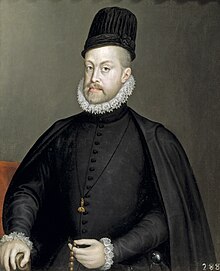 Global Information
Global InformationPhilip II of Spain information
| Philip II | |
|---|---|
 Portrait by Sofonisba Anguissola (1565) | |
| King of Spain | |
| Reign | 16 January 1556 – 13 September 1598 |
| Predecessor | Charles I |
| Successor | Philip III |
| King of Portugal | |
| Reign | 12 September 1580 – 13 September 1598 |
| Acclamation | 16 April 1581, Tomar |
| Predecessor | Henry or Anthony (disputed) |
| Successor | Philip III of Spain |
| King of England and Ireland | |
| Reign | 25 July 1554 – 17 November 1558 |
| Predecessor | Mary I |
| Successor | Elizabeth I |
| Co-monarch | Mary I |
| Born | 21 May 1527 Palacio de Pimentel, Valladolid, Crown of Castile |
| Died | 13 September 1598 (aged 71) El Escorial, San Lorenzo de El Escorial, Crown of Castile |
| Burial | El Escorial |
| Spouses | Maria Manuela of Portugal
(m. 1543; died 1545)Mary I of England
(m. 1554; died 1558)Elisabeth of Valois
(m. 1559; died 1568)Anna of Austria
(m. 1570; died 1580) |
| Issue more... |
|
| House | Habsburg |
| Father | Charles V, Holy Roman Emperor |
| Mother | Isabella of Portugal |
| Religion | Roman Catholicism |
| Signature | |
Philip II[note 1] (21 May 1527 – 13 September 1598), also known as Philip the Prudent (Spanish: Felipe el Prudente), was King of Spain[note 2] from 1556, King of Portugal from 1580, and King of Naples and Sicily from 1554 until his death in 1598. He was also jure uxoris King of England and Ireland from his marriage to Queen Mary I in 1554 until her death in 1558.[1] He was also Duke of Milan from 1540.[2] From 1555, he was Lord of the Seventeen Provinces of the Netherlands.
The son of Emperor Charles V and Isabella of Portugal, Philip inherited his father's Spanish Empire in 1556 and succeeded to the Portuguese throne in 1580 following a dynastic crisis. The Spanish conquests of the Inca Empire and of the Philippines, named in his honor by Ruy López de Villalobos, were completed during his reign. Under Philip II, Spain reached the height of its influence and power, sometimes called the Spanish Golden Age, and ruled territories in every continent then known to Europeans. Philip led a highly debt-leveraged regime, seeing state defaults in 1557, 1560, 1569, 1575, and 1596. This policy was partly the cause of the declaration of independence that created the Dutch Republic in 1581. Philip finished building the royal palace El Escorial in 1584.
Deeply devout, Philip saw himself as the defender of Catholic Europe against the Ottoman Empire and the Protestant Reformation. In 1584, Philip signed the Treaty of Joinville funding the French Catholic League over the following decade in its civil war against the French Huguenots. In 1588, he sent an armada to invade Protestant England, with the strategic aim of overthrowing Elizabeth I and re-establishing Catholicism there, but his fleet was defeated in a skirmish at Gravelines (northern France) and then destroyed by storms as it circled the British Isles to return to Spain. The following year Philip's naval power was able to recover after the failed invasion of the English Armada into Spain. Two more Spanish armadas unsuccessfully tried to invade England in 1596 and 1597. The Anglo-Spanish war carried on until 1604, six years after Philip's death.[3][4]
Under Philip, an average of about 9,000 soldiers were recruited from Spain each year, rising to as many as 20,000 in crisis years. Between 1567 and 1574, nearly 43,000 men left Spain to fight in Italy and the Low Countries (modern-day Belgium, Luxembourg, and the Netherlands).[5]
Cite error: There are <ref group=note> tags on this page, but the references will not show without a {{reflist|group=note}} template (see the help page).
- ^ Geoffrey Parker. The Grand Strategy of Philip II (2000)
- ^ Garret Mattingly. The Armada pp. 22, 66. ISBN 0-395-08366-4.
- ^ Rowse, A. L. (1969). Tudor Cornwall: Portrait of a Society. C. Scribner, p. 400
- ^ "One decisive action might have forced Philip II to the negotiating table and avoided fourteen years of continuing warfare. Instead the King was able to use the brief respite to rebuild his naval forces and by the end of 1589 Spain once again had an Atlantic fleet strong enough to escort the American treasure ships home." The Mariner's Mirror, Volumes 76–77. Society for Nautical Research, 1990
- ^ Kamen, Henry (2014). Spain, 1469–1714: A Society of Conflict. Routledge. p. 150.